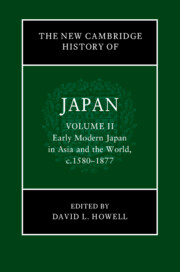Book contents
- The New Cambridge History of Japan
- The New Cambridge History of Japan
- The New Cambridge History of Japan
- Copyright page
- Contents
- Figures
- Maps
- Tables
- Contributors to Volume II
- Preface
- Frontispiece
- Introduction
- Part I The Character of the Early Modern State
- PART II Economy, Environment, and Technology
- Part III Social Practices and Cultures of Early Modern Japan
- 13 Religion in the Tokugawa Period
- 14 The Medical Revolution in Early Modern Japan
- 15 Flows of People and Things in Early Modern Japan
- 16 Labor and Migration in Tokugawa Japan
- 17 The Tokugawa Status Order
- 18 On the Peripheries of the Japanese Archipelago
- 19 The Early Modern City in Japan
- 20 Popular Movements in Early Modern Japan
- 21 Civilization and Enlightenment in Early Meiji Japan
- Index
- References
21 - Civilization and Enlightenment in Early Meiji Japan
from Part III - Social Practices and Cultures of Early Modern Japan
Published online by Cambridge University Press: 15 January 2024
- The New Cambridge History of Japan
- The New Cambridge History of Japan
- The New Cambridge History of Japan
- Copyright page
- Contents
- Figures
- Maps
- Tables
- Contributors to Volume II
- Preface
- Frontispiece
- Introduction
- Part I The Character of the Early Modern State
- PART II Economy, Environment, and Technology
- Part III Social Practices and Cultures of Early Modern Japan
- 13 Religion in the Tokugawa Period
- 14 The Medical Revolution in Early Modern Japan
- 15 Flows of People and Things in Early Modern Japan
- 16 Labor and Migration in Tokugawa Japan
- 17 The Tokugawa Status Order
- 18 On the Peripheries of the Japanese Archipelago
- 19 The Early Modern City in Japan
- 20 Popular Movements in Early Modern Japan
- 21 Civilization and Enlightenment in Early Meiji Japan
- Index
- References
Summary
This chapter surveys Japan’s era of civilization and enlightenment (bunmei kaika), roughly the first decade of the Meiji era (1868–1912). It interprets bunmei kaika as a revolutionary attempt at Westernization intended to overcome the disruption wrought by the globalizing effects of Western imperialism. The chapter covers four categories: first, politics and war, including the Iwakura Mission, the political crisis of 1873, the movement for freedom and peoples’ rights, the invasion of Taiwan, the Saga Rebellion, the incident at Kanghwa Island, the Shinpūren Rebellion, and the civil war of 1877; second, thought, including intellectual societies, the ideas of civilization and the nation, religion, language, and the public sphere; third, society, including household registration, taxes and allowances, the military, education, gender, and law enforcement; and fourth, culture, including the emperor, clothes, food, transportation, and time. It stresses disorder as integral to these transformations of the 1870s.
Keywords
- Type
- Chapter
- Information
- The New Cambridge History of Japan , pp. 689 - 738Publisher: Cambridge University PressPrint publication year: 2023

